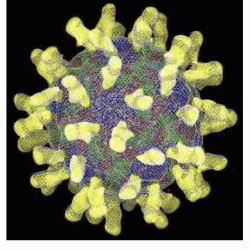Source Institutions
Source Institutions
Add to list Go to activity
Activity link broken? See if it's at the internet archive

In this activity on page 3 of the PDF, learners visualize the relative size and structural differences between microbes that have the potential to cause disease. Learners work in groups and use simple materials to build scale models of different types of viruses. This activity can be preceded by "Line 'em up!", the first activity in this resource, located on page 1 of the PDF.
- 5 to 10 minutes
- 1 to 2 hours
- $10 - $20 per group of students
- Ages 11 - 18
- Activity, Lesson/Lesson Plan, Model
- English
Quick Guide
Materials List (per group of students)
- rulers and meter sticks
- scissors
- construction paper
- balloons
- glue and tape
- tooth picks
- clay
- chenille craft sticks
- other misc. disposable objects that students can use to construct a model
Keywords
- microbe
- biology
- bacteria
- size
- DNA
- virus
- disease
- illness
- micrometer
- millimeter
- nanometer
- scale
- red blood cell
- diameter
- lymphocyte
- structure
- capsid
- parasite
- obligate parasite
- prokaryotes
- antibiotics
- bacteriophage
- enveloped
- HIV
- cold sores
- herpes simplex virus-1
- adenovirus
- influenza
- ebola
- papillomavirus
- rabies
- hepatitis B
- rhinovirus
- lyme disease
- whooping cough
- E. Coli
- stomach ulcer
- strep throat
- streptococcus
- Escherichia coli
Subjects
-
Life Sciences
-
Cells
- Cell Structure and Function
-
Diversity of Life
- Viruses and Bacteria
- Classification
-
Heredity and Genetics
- DNA Structure and Function
-
Human Body
- Health and Nutrition
- Medicine
- Immune System
-
Cells
-
Mathematics
-
Measurement
- Units of Measurement
- Size and Scale
- Circles
- Representation
-
Measurement
-
The Nature of Technology
-
The Design Process
- Problem Solving
-
The Design Process
-
The Nature of Science
-
The Scientific Process
- Conducting Investigations
- Formulating Explanations
-
The Scientific Process
Informal Categories
- Model Building
Audience
To use this activity, learners need to:
- see
- read
- touch
Learning styles supported:
- Involves teamwork and communication skills
- Involves hands-on or lab activities
Other
This resource is part of:
Access Rights:
- Free access
By:
- Yu, Julie
Rights:
- All rights reserved, Exploratorium, 2006
Funding Sources:
- National Science Foundation, 0610238
- National Science Foundation, 0925383
